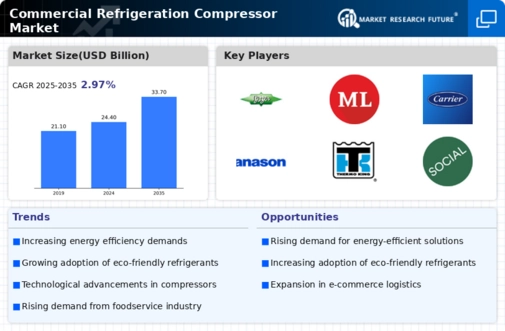Increasing Focus on Energy Efficiency
The increasing focus on energy efficiency is a pivotal driver in the Commercial Refrigeration Compressor Market. As energy costs continue to rise, businesses are seeking ways to reduce operational expenses, making energy-efficient refrigeration systems more attractive. Recent studies suggest that energy-efficient compressors can reduce energy consumption by up to 30%, leading to significant cost savings over time. This trend is particularly relevant in sectors such as retail and food service, where refrigeration accounts for a substantial portion of energy usage. As a result, manufacturers are investing in research and development to create compressors that not only comply with energy efficiency standards but also offer enhanced performance. The growing emphasis on sustainability and cost-effectiveness is likely to propel the demand for advanced refrigeration compressors in the coming years.
Growth of the Food and Beverage Sector
The expansion of the food and beverage sector is a significant driver of the Commercial Refrigeration Compressor Market. As consumer preferences shift towards convenience and quality, the demand for refrigerated products continues to rise. The food retail segment, including supermarkets and convenience stores, is experiencing robust growth, with projections indicating a steady increase in the number of outlets. This trend necessitates the installation of efficient refrigeration systems to ensure product freshness and safety. Additionally, the rise in food delivery services and meal kits further amplifies the need for reliable refrigeration solutions. Consequently, manufacturers are focusing on developing compressors that can meet the specific requirements of this dynamic market, thereby driving overall industry growth.
Rising Demand for Refrigerated Storage
The increasing demand for refrigerated storage solutions is a primary driver in the Commercial Refrigeration Compressor Market. As the food and beverage sector expands, the need for efficient refrigeration systems becomes paramount. According to recent data, the food service industry is projected to grow at a compound annual growth rate of approximately 5.5% over the next few years. This growth necessitates advanced refrigeration compressors that can maintain optimal temperatures while minimizing energy consumption. Additionally, the rise in e-commerce and online grocery shopping further fuels the demand for reliable refrigeration systems, as consumers expect fresh products delivered promptly. Consequently, manufacturers are focusing on developing innovative compressor technologies that cater to these evolving market needs.
Technological Advancements in Compressor Design
Technological advancements are significantly influencing the Commercial Refrigeration Compressor Market. Innovations in compressor design, such as variable speed drives and advanced control systems, are enhancing the efficiency and performance of refrigeration units. These technologies allow for better temperature control and energy savings, which are critical in commercial applications. Market data indicates that the adoption of inverter-driven compressors is on the rise, as they offer improved energy efficiency and reduced operational costs. Furthermore, the integration of IoT and smart technologies into compressor systems is enabling real-time monitoring and predictive maintenance, thereby extending the lifespan of refrigeration units. As these technologies continue to evolve, they are expected to drive the market forward, catering to the growing demand for efficient refrigeration solutions.
Regulatory Compliance and Environmental Standards
Regulatory compliance plays a crucial role in shaping the Commercial Refrigeration Compressor Market. Governments worldwide are implementing stringent regulations aimed at reducing greenhouse gas emissions and promoting energy efficiency. For instance, the introduction of the F-Gas Regulation in various regions mandates the phase-out of high-GWP refrigerants, pushing manufacturers to innovate and adopt eco-friendly alternatives. This regulatory landscape compels companies to invest in advanced compressor technologies that not only meet compliance standards but also enhance operational efficiency. The market for low-GWP refrigerants is expected to witness substantial growth, as businesses seek to align with environmental policies while maintaining competitive advantages. Thus, adherence to these regulations is likely to drive the demand for advanced refrigeration compressors.


















Leave a Comment